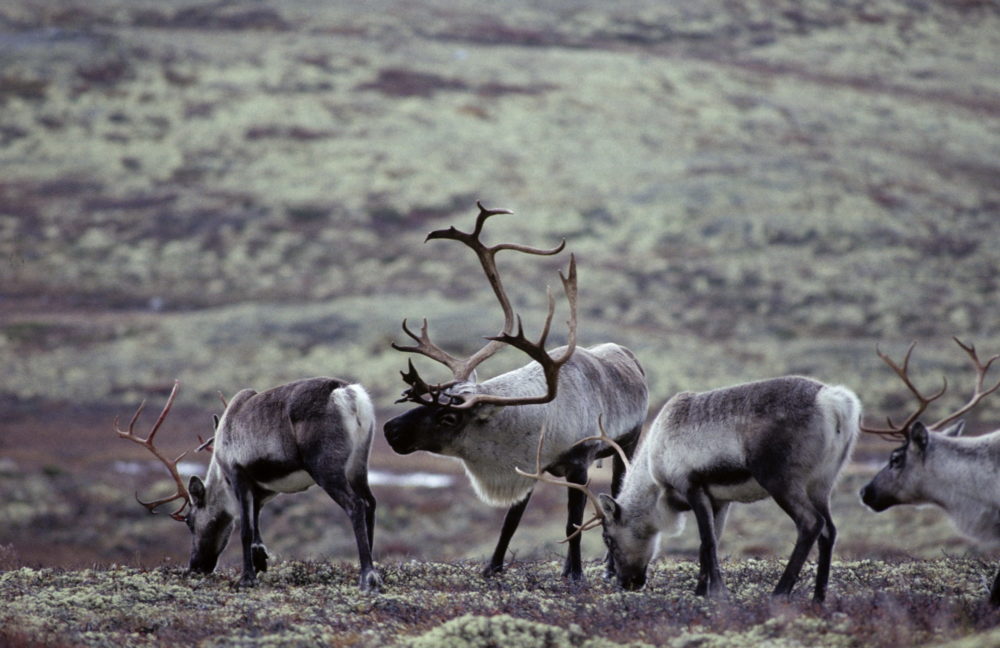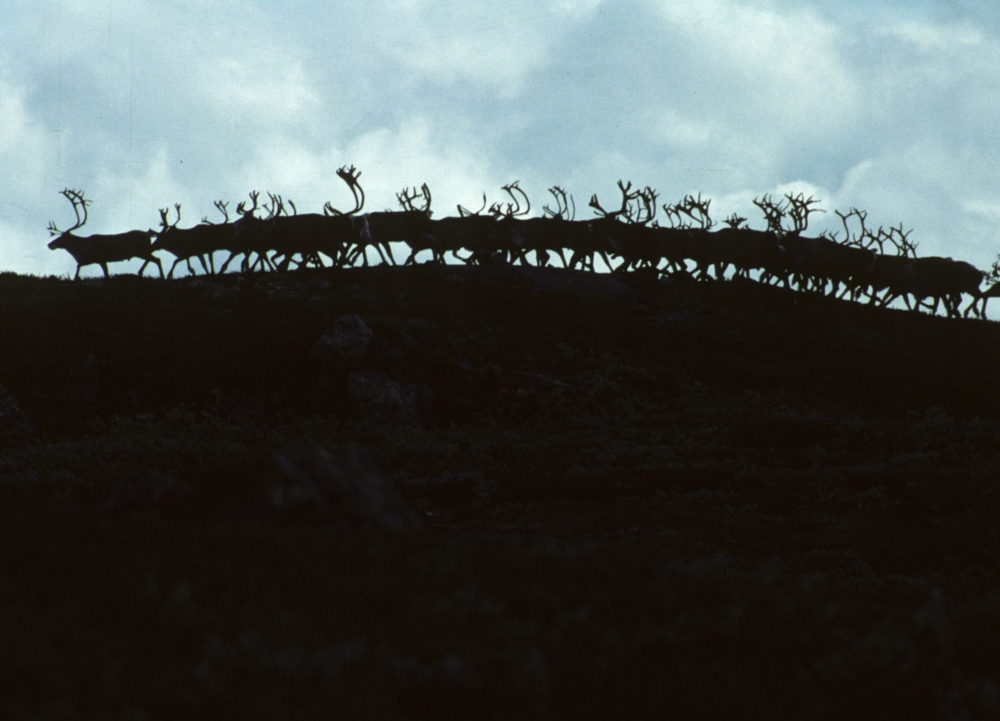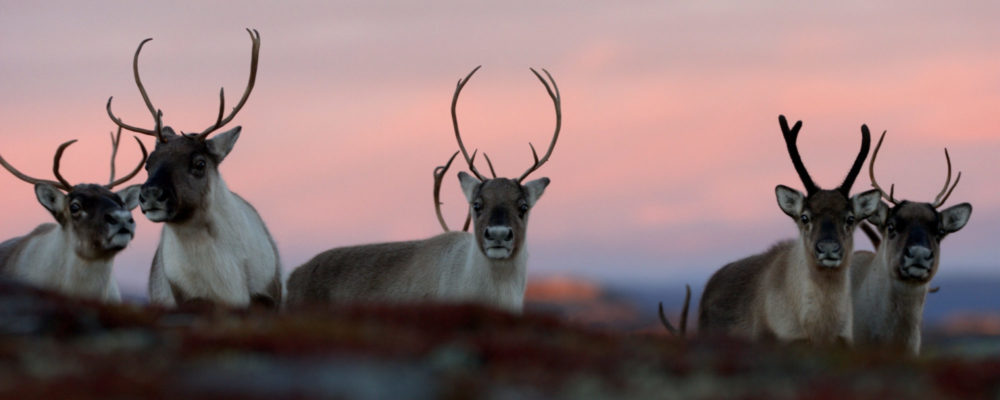Reindeer
In Norway, we mainly have two types of reindeer: wild reindeer and domestic reindeer. They are both the same species, but as domestic reindeer are regarded as domestic animals, we will focus on wild reindeer here. Reindeer live in large herds, which move around in the mountains. This itinerant lifestyle has led to reindeer being nicknamed the ‘nomads of the mountains’. The male reindeer is called a bull, while the female is a cow. The young are called calves.
Reindeer facts
Latin: Rangifer tarandus
Family: Deer (Cervidae)
Height: 110 – 130 cm
Weight: Max. 270 kg
Breeding season: September – October
Number of calves: 1
Lifespan: 10 – 15 years
 Reindeer tracks
Reindeer tracks
The reindeer’s tracks are distinctly rounded and almost form a circle. The dew claws stick out sharply and are generally clearly visible in the tracks.
How does the reindeer live?
Reindeer are gregarious animals, which means they live in herds. There can be as many as several hundred of them in a herd. This provides good protection against predators. The more animals there are in the herd, the smaller the chance for the individual of being eaten by predators.
The reindeer travels in two different herds: the male herd and the female herd. The male herd is made up of adult bulls (males), who stick together outside the breeding season (rut). The female herd, on the other hand, consists of cows (females), calves and young animals. The male and female herds come together when the breeding season, or rut as it is called, gets under way. At this time of year, the bulls’ antlers are fully grown, ready to impress the females. They will also have fights with the aim of showing off their size and strength to the cows. The most impressive bulls get to mate. When the breeding season is over, the bulls’ antlers have done their job and are shed. With reindeer, the females also have antlers, which they keep through the winter. In addition, the calves acquire antlers in their first year of life. In the reindeer world, the animals with the biggest antlers have the highest social status, and when the bulls lose their antlers, they end up at the bottom of the pecking order. This is important in guaranteeing that the cows, which may now be pregnant, take precedence when it comes to competing for the best grazing areas in winter. It is vital for a pregnant cow to obtain enough sustenance for her calf to be able to grow inside her.
The calves are generally born in May after the cows have migrated to specific calving areas. Calving itself is over in less than half an hour, and the calf will be up on its legs just as quickly. The reindeer will now stay in the calving area for a few days until the calf is ready to follow its mother to new grazing.

What does the reindeer eat?
Reindeer are, perhaps, best known for eating lichen, which is their most important food in winter. Lichens such as Cladonia stellaris and Cetraria nivalis are the most nutritious and therefore most popular, but the reindeer can also eat other types of lichen if it needs to. To reach the lichen during winter the reindeer search out smaller hills where the snow isn’t as deep, and use their round, shovel-like hooves to dig down through the snow. Lichen is not very rich in nutrients and largely consists of fast carbohydrates. This means that the reindeer cannot survive on a lichen-only diet. Lichen is mainly for surviving through the winter, while reindeer eat properly in the summer. When the snow melts, new shoots will rapidly appear and turn things green. The reindeer will graze on these fresh shoots, as they are most nutritious. It can also graze on dwarf birch and willow in the mountains. In the autumn, the reindeer can also eat mushrooms, and may drop down a little way into the birch belt to find it.
Where does the reindeer live?
The wild reindeer we have in mainland Norway live in the high mountains south of Trøndelag. In other words, the reindeer in the rest of the country are domestic reindeer. We also have reindeer on Svalbard, but they are a slightly smaller, short-legged subspecies known as the Svalbard reindeer (Rangifer tarandus platyrhynchus).
Reindeer will roam over large distances in order to move between different grazing and calving areas. They live a nomadic life and are always on the move. Reindeer prefer to move against the wind. This makes it easy for them to scent danger ahaed.
How many reindeer do we have in Norway?
Wild reindeer are divided into several populations, the largest of which is found at Hardangervidda. It is home to around 10,000 animals. All in all, we have around 25,000 wild reindeer in Norway.
We have far more domestic reindeer than wild reindeer. There are approximately 250,000 domestic reindeer in the country. Most of them are in Finnmark, which is home to 185,000 domestic reindeer!

LEARN MORE ABOUT WILD REINDEER
Du kan lære mer om villrein på følgende sider:
- The Norwegian Wild Reindeer Centre.
- The Norwegian Institute for Nature Research’s webpages on wild reindeer (NINA).
- The Norwegian Environment Agency’s webpages on wild reindeer.
- Wild reindeer on Hjorteviltportalen (Game Deer Portal).
We have also used them as sources for our information page on reindeer.
This article has been written by Nicklas Iversen, a former nature guide, and updated by Fredrik Lehn-Pedersen, nature guide for Visitor Centre Carnivore Flå.
